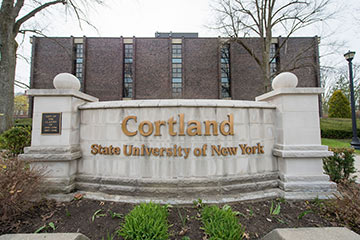
06/12/2020
The following message was sent to SUNY Cortland students, faculty and staff on behalf of President Erik J. Bitterbaum.
To the SUNY Cortland community,
The process of returning to campus for the fall 2020 semester is complex, extensive and dramatically different from our traditional way of operating. That makes transparency and communication more important than ever.
To that end, today we are launching Restart SUNY Cortland, a website designed to give students, parents, faculty and staff a single, reliable location for updated information related to the steps needed to safely provide on-campus education this fall.
The site, which will grow in scope and depth, is currently built around the restart plan SUNY Cortland submitted to SUNY administration late last week. We are sharing that plan with you, making it public in an easily accessible digital format.
The new site will have a searchable news feed for all SUNY Cortland messages related to our reopening — including my weekly Friday updates — and will eventually include Frequently Asked Questions tailored to students, faculty and staff. I encourage you to bookmark this site and use it as a resource.
We are confident that our plan will allow us to welcome our community back to campus in a way that protects vulnerable people, ensures social distancing and helps prevent the spread of COVID-19. It is a framework that will evolve to include more detailed policies and procedures as we near the start of the semester and the course of the virus becomes clearer.
Proposed changes that students and families should be aware of include:
Fall calendar. Classes will start as scheduled on Monday, Aug. 31, but there will be no breaks until Nov. 20, the Friday before Thanksgiving, in order to limit potential exposure from students going home and then returning to Cortland. Labor Day, Monday, Sept. 7, will be a regular class day and there will be no fall break. There will be no classes during the week of Thanksgiving, allowing time for students to move out of their campus residence halls and return home. The remaining two weeks of classes (Nov. 30 to Dec. 11) and finals week (Dec. 14-18) will be conducted virtually.
Classes. Courses will likely be delivered in hybrid form, a combination of online and in-person teaching. Large lecture courses are proposed to be taught online, and classrooms will be reconfigured to accommodate social distancing during in-person instruction. To reduce density, some classes will rotate students to physically attend classes part of the time and participate virtually part of the time.
Screening. Health screening assessments will be required before students come to campus and testing and other protocols will be required under certain circumstances.
Physical distancing and masks. All people on campus will be required to maintain a minimum of six feet of space between themselves and others. In-person gatherings will be limited, and alternatives sought for large meetings and events. New pedestrian traffic patterns will be required throughout campus. Safety starts with each individual and their personal responsibility to protect themselves and others. The first and last means of defense, and the clearest way to demonstrate this responsibility is wearing a mask while near others on campus. That way, people who find themselves suddenly unable to maintain six feet of distance will have some level of protection.
Hygiene and cleaning. Increased cleaning and sanitization efforts will be implemented to meet CDC and DOH requirements. Staff will have increased availability of personal protective equipment, cleaning supplies, disinfectants, hand washing products and hand sanitizer. There will be a significant education effort related to the importance of proper hygiene practices.
Housing. SUNY Cortland will need to eliminate all tripling of students in residence hall rooms and is negotiating to secure additional student housing near campus. The university is also working to acquire additional rooms for quarantine and isolation purposes.
Flexibility to accommodate high risk and other personal needs. We will work to provide reasonable accommodations for faculty, staff and students in high-risk categories.
As you can see, there is much work to be done. It will require the cooperation and collaboration of everyone in our community. And I have no doubt our community will once again rise to the challenge.
Be strong, remain engaged and stay safe.
All the best,
Erik J. Bitterbaum